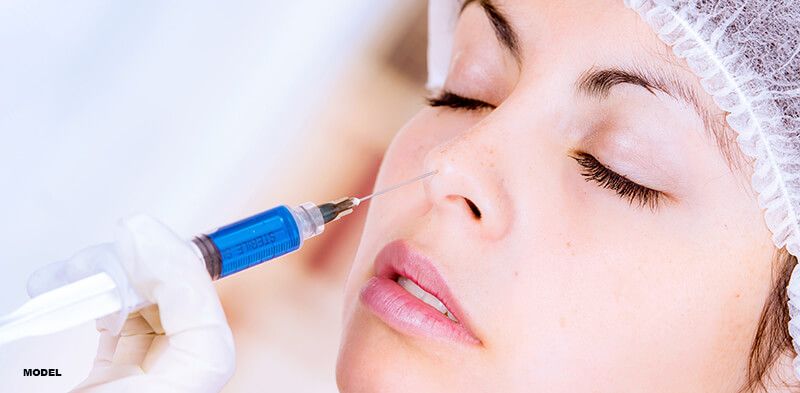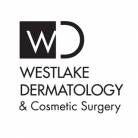Delayed Onset Signs and Symptoms of Vascular Occlusion to Liquid Rhinoplasty in a Fitzpatrick Skin Type IV Patient

Written By: Alyssa Rodriguez, MA and Callie Kurpiewski, MA
The staff of Westlake Dermatology & Cosmetic Surgery is constantly investing in continuous learning in order to improve procedural efficacy and safety for our patients. The following is a research paper written by our own Alyssa Rodriquez and Callie Kurpiewski with some input from Dr. Gregory Nikolaidis:
Abstract
Vascular occlusions due to liquid rhinoplasty are rare, but can result in tissue necrosis and blindness. This complication is not exhaustively documented in the literature, especially in people of color. Here we present the case of a 25-year-old male with a post traumatic deviated nasal bridge who developed a vascular occlusion following liquid rhinoplasty. Prompt use of intralesional hyaluronidase injections and topical nitroglycerin ointment led to a restoration of normal tissue vascularity with no long-term cosmetic sequelae.
Introduction
A nonsurgical rhinoplasty (NSR), colloquially known as a “liquid rhino,” entails the injection of a soft-tissue filler into the nasal bridge and tip to improve the cosmetic appearance of the nose. First reported in the early 19th century, where injections of liquid paraffin were used to correct saddle nose deformity, modern NSR has evolved significantly, using hyaluronic acid (HA) or calcium hydroxyapatite to produce cosmetic results (1,2,3). While not a complete substitute for traditional rhinoplasty, NSR can yield satisfactory results for patients seeking subtle improvements in the contour of their nose, with minimal pain, downtime, and only topical anesthesia (2, 4). Targeted volume placement in the nose can enhance its shape, softening a dorsal hump or correcting tip shape. However, decreasing the size of the nose or correcting functional issues are not achievable (2). The results of NSR typically last between 12-18 months (5).
Common post treatment adverse events from NSR include bruising, pain, edema, and dyspigmentation; these are self-limited and arise from provider technique, product selection, or patient risk factors (6). Uncommon complications include filler migration (rare with nasal filler), local infection, reactivation of herpes simplex virus, and embolization of vessels resulting in skin necrosis or blindness (7).
We present a case of vascular occlusion caused by HA filler injected into the nasal bridge and tip. Given the gap in the current medical literature about vascular occlusions of the nose, particularly in patients of color, we believe the teaching points of this case may be of great value to other providers.
Case Report
The patient was a 25-year-old African American male with no known drug allergies, chronic medical conditions, or medications. He reported having been in a physical altercation years earlier that led to a nasal fracture and subsequent visible deviation of his nasal bridge, the impetus for his seeking NSR. The patient was counseled on the risks, benefits, and alternatives to NSR. The patient was cautioned that his risk for vascular occlusion may be higher due to his previous soft-tissue injury. He elected to proceed with treatment, which would be his first elective cosmetic procedure.
The patient was reclined at a 30* angle. HA filler (Teosyal RHA-3, Revance Therapeutics, Inc, Nashville, TN) was injected supraperiosteally in the nasal bridge in order to camouflage the dorsal nasal hump. Injection of the lower nasal tip was then performed subcutaneously, so as to refine the shape and slope of the tip. The pyriform aperture was injected last, providing adequate support for the nose and preventing any downward rotation of the nasal tip caused by the weight of the overlying filler. A total of 1.0 mL of HA filler was injected. No adverse events were noted during or immediately following treatment.
Two days post-procedure, the patient reported pain, redness, and swelling of the nasal tip. Markedly slow capillary refill was noted on examination, indicating a high probability of vascular occlusion secondary to the recently injected HA filler. A total of 540 U (2.7 mL) of hyaluronidase (Vitrase, Bausch & Lomb, Inc., Laval, Canada) was injected into the affected areas of the nasal tip. Acetaminophen 975 mg was given to the patient in-office and 7-day courses of doxycycline (100mg qdaily) and aspirin (181 mg daily) were prescribed.
On re-evaluation 4 hours later, the patient reported more swelling and slight hyperpigmentation of the area. An additional 200 U (1.0 mL) of hyaluronidase was injected into the nasal tip and bridge, topical 2% nitroglycerin (glyceryl trinitrate) ointment was applied, and 100% oxygen was given for 20 minutes. Upon a second examination Dr. Nikolaidis suggested the possibility of residual filler causing a pressure phenomena leading to a partial vascular occlusion.
Three days post-procedure, the patient’s capillary refill time was still observed to be slow, at which point an additional 200 U of hyaluronidase was injected into the nasal tip and left side of the nasal bridge. Capillary refill returned to normal immediately following injection. Nitroglycerin ointment was again applied to the area and sterile saline soaks were recommended for at-home treatment. On day 4, normal capillary refill time was observed, and the patient reported no pain. A final 200 U of hyaluronidase was injected into the nasal tip on day 5. At 2 weeks post treatment, the patient reported using sterile soaks and petrolatum ointment for the mild persistent crusting and hyperpigmentation on the nasal tip. However, no texture irregularities of the skin were noted.
Discussion
A review of 5,000 cases of NSR by Harb and Brewster (8) reported 24 cases (0.48%) of arterial occlusion, highlighting the rare nature of this serious complication. The most common site of occlusion was the nasal tip. Twenty percent of the treated patients sought NSR for post-surgical correction. Traditional rhinoplasty and other forms of physical trauma to the nose can result in distortion of the complex, delicate vascular network within nasal soft tissue. Prior physical trauma may have thereby played a direct role in the development of the vascular occlusion reported here.
Signs and symptoms of vascular occlusion from filler may be immediately noticeable or develop hours to days following treatment (9). Regardless, rapid treatment of a suspected vascular occlusion from filler injection with hyaluronidase is vital to restoring normal capillary refill, leading to full recovery with no lasting cosmetic sequelae (10,11). Adjunct use of nitroglycerin ointment (vasodilator and analgesic) and antibiotics (anti-inflammatory and mitigator of secondary infection) may also be helpful. Post treatment lasers therapy is a valuable option for post-inflammatory erythema or hyperpigmentation, if present.
Conclusion
Signs and symptoms of vascular occlusion from NSR with HA filler are not always visible immediately post treatment. Delayed-onset findings suspicious for a vascular occlusion should be treated with hyaluronidase injections as quickly as possible to prevent lasting damage such as necrosis. Cosmetic providers should instruct patients about potential warning signs post treatment.
References
- https://onlinelibrary.wiley.com/doi/abs/10.1111/jocd.14489
- https://www.plasticsurgery.org/news/blog/what-is-liquid-rhinoplasty
- Injectable Fillers Facial Shaping and Contouring by Derek H. Jones and Arthur Swift
- https://www.ncbi.nlm.nih.gov/pmc/articles/PMC4379228/
- https://www.ncbi.nlm.nih.gov/pmc/articles/PMC7028373/
- https://search.lib.utexas.edu/permalink/01UTAU_INST/apl7st/cdi_doaj_primary_oai_doaj_org_article_d05a8871b20b488bbf5fcc873ce9a4b8
- https://search.lib.utexas.edu/permalink/01UTAU_INST/apl7st/cdi_pubmed_primary_29305643
- https://journals.lww.com/plasreconsurg/Fulltext/2020/03000/The_Nonsurgical_Rhinoplasty__A_Retrospective.15.aspx
- https://www.ncbi.nlm.nih.gov/pmc/articles/PMC7209845/
- https://search.lib.utexas.edu/permalink/01UTAU_INST/apl7st/cdi_doaj_primary_oai_doaj_org_article_c30cc013aa724a418ec759bbec13563b
- https://www.ncbi.nlm.nih.gov/pmc/articles/PMC4689510/
Disclaimer: The contents of the Westlake Dermatology website, including text, graphics, and images, are for informational purposes only and are not intended to substitute for direct medical advice from your physician or other qualified professional.
